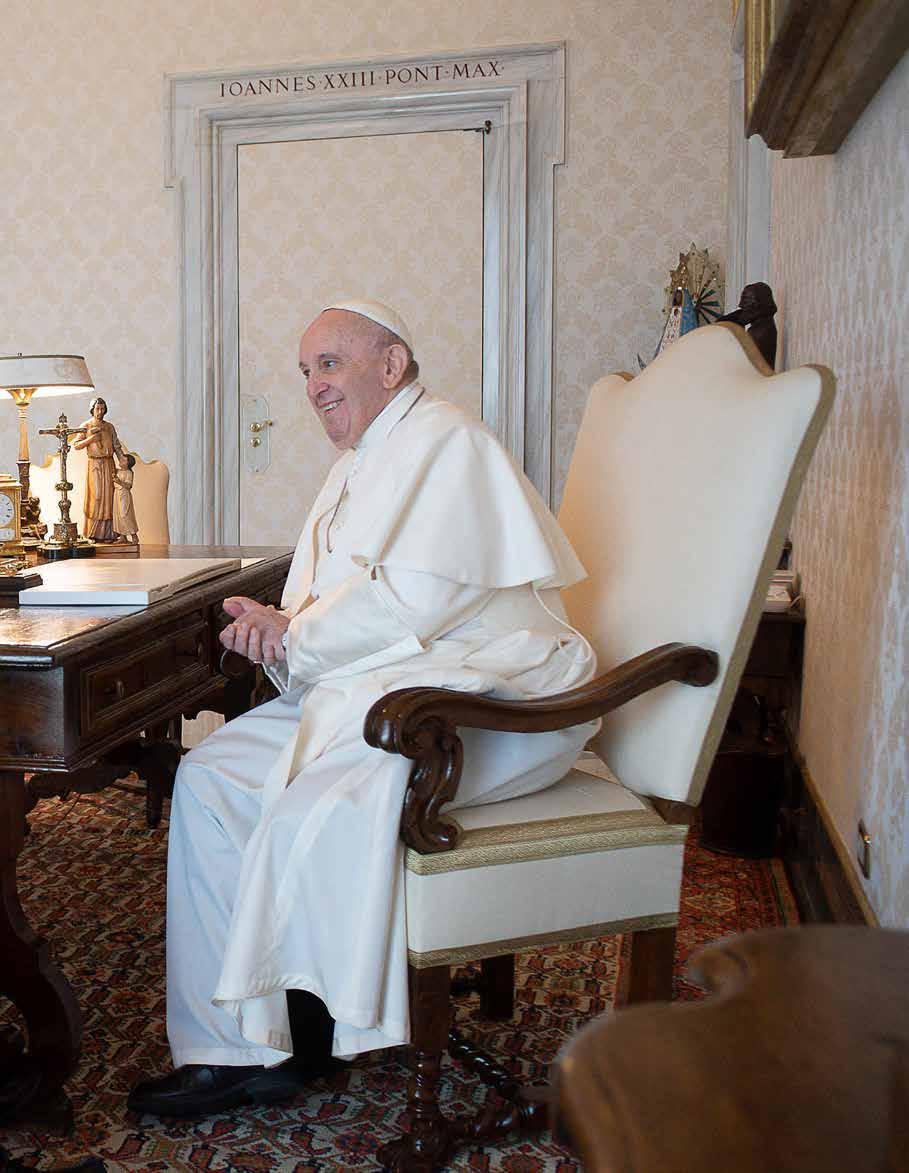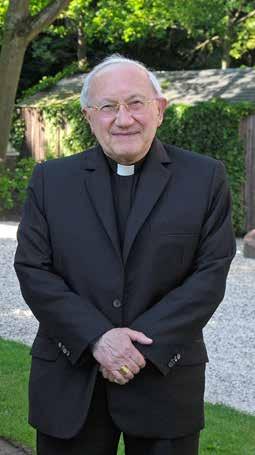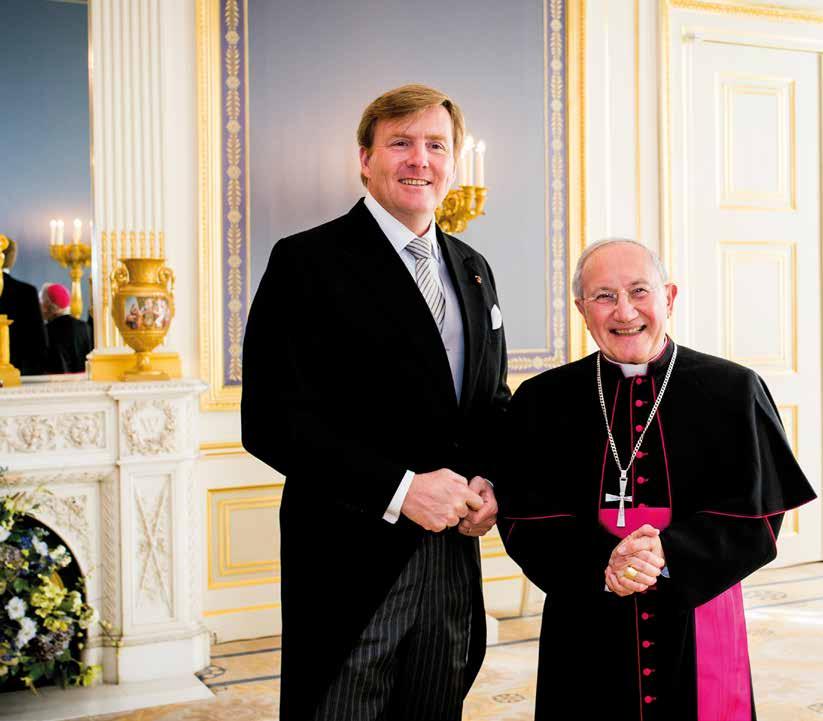
5 minute read
Eyes on The Holy See
Pope Francis meets with H.E. Mgr. Aldo Cavalli, Apostolic Nuncio in the Netherlands Photo: ANP IPA/ABACA
Highlight on the Holy See

The Papal Nuncio, Archbishop Mgr. Aldo Cavalli, who represents the Holy See to the Kingdom of the Netherlands, presented his credentials to His Majesty King Willem-Alexander in May 2015. The Nuncio serves as the connecting link between the Pope and the Catholic Church in the Netherlands, and between the Holy See and the Government of the Kingdom of the Netherlands. Diplomat Affairs Magazine was delighted with this unique opportunity to interview His Excellency the Nuncio.
EExcellency, after being posted as the representative of the Holy See in Malta and Libya, you became the representative here in the Netherlands. What would you say is the key ingredient for a successful mission? In the course of my life in service of Diplomacy for the Holy See, I have had the opportunity, like all Diplomats, to live in different countries. There is a key word to understand the characteristic attitude for every change of mission: culture. In order to be able to carry out a mission in a new country in an efficient and fruitful way, it is mandatory to learn the beliefs, law, morals, art, that is to say the culture of the people who live in that country. It is necessary to learn and understand that, in order to be able to dialogue, we need to use the same “language’, enabling reception and transmission of constructive thoughts and initiatives. This is what I endeavoured to put into practice when I was sent from the mission in Malta and Libya to the Netherlands. For us outsiders, the world of the Holy See is not always clear. Could you possibly explain the difference between the Holy See and the Vatican? The term “Holy See” is very old. I believe that it is only possible to understand it if one understands the foundation of the context of the reality of the Christian community, the “Church”, in which the Holy See is located. The foundation of the Church is Faith in Jesus Christ, the Son of God, who came among us about 2000 years ago, who founded a community, the Church, giving it the mission of transmitting this Faith to the whole world. This community (the Church) spread throughout the then known world, and reached Rome, the capital of the Roman Empire, where the principal person in charge of the Church (the Bishop), whose name was Peter, established his “See” (seat). His successors as Bishops of Rome, were given the title of Pope (Father) and the “See” from which they taught and directed the community, became a point of reference for the whole Church around the world, calling itself the “Holy See”, which represents the Pope and those who assist him in carrying out his ministry (the “Curia”). As it advanced through history, this “Community of Faith”, has gone through various vicissitudes, but has always retained its original initial foundation: • In the fifth century, after the fall of the Roman Empire, the Pope had to assume both the task of organizing the Roman people, left without means to live, and the function of dialogue with the peoples of the North, who had conquered the Roman Empire. • In the eighth century, the function of the Pope in all central Italy became so important that, in the context of the political and cultural arrangements of that time, it became a State, the “Papal States”. This situation lasted for a thousand years, until 1870, when the Kingdom of Italy was established. The Pope no longer possessed anything, but, for historical reasons, he continued to send and receive Ambassadors and to sign International Treaties in the name “Holy See”, considered a “Subject of International Law” on a par with a State. • Again, for historical reasons, in 1929 the Holy See and the Kingdom of Italy signed a Treaty which established the “Vatican City State”, which was to guarantee the Pope’s freedom to carry out his mission, remaining distinct from the Holy See. In the midst of all these historical events, the initial “Community of Faith” continues its journey through history with also the “Holy See” as a “Subject of International Law”, which sends out Ambassadors (the Apostolic Nuncios) and receives Ambassadors, is an active part of the United Nations Organization and of many other international Organizations, with the aim of collaborating for the peace and well-being of all the peoples of our world. At the Pontifical Ecclesiastical Academy’s diplomat training, you specialized in theology and canon law, before graduating in political sciences. Are these studies a requirement for a diplomatic career? The “Diplomatic Corps of the Holy See” is educated in the Pontifical Ecclesiastical Academy, an extraterritorial palace, which has had its headquarters in Rome for the past three centuries. Priests, sent by Dioceses from all over the world, who have already completed


His Excellency Monseigneur Aldo Cavalli presenting his credentials to His Majesty King Willem-Alexander (2015).
their higher studies in Theology, are welcomed there. During their stay in Rome, they attend the Faculty of Canon Law in one of the Pontifical Universities. Before starting the Diplomatic mission, all candidates must obtain a Doctorate. The number of baptized Catholics in the world was about 1.329 billion at the end of 2018, how large is the Dutch catholic community? The Catholic community in the Netherlands comprises 20,1% (figures CBS 2019) of the population (about 3,5 million). “WE HAVE CONTINUED TO CELEBRATE HOLY MASS EVERY DAY IN THE CHAPEL OF THE NUNCIATURE.”
Before Covid-19 disrupted all our lives, you held a mass every morning at the Chapel of your Residence. How is the situation now? We have continued to celebrate Holy Mass every day in the Chapel of the Nunciature. During the period of Covid-19, we had to limit the number of people attending, in accordance with the indications given by the Dutch authorities. Thank you Your Excellency, for having taken the time to answer our questions, and shed a light on these topics, sharing the History and mission of the Holy See.










